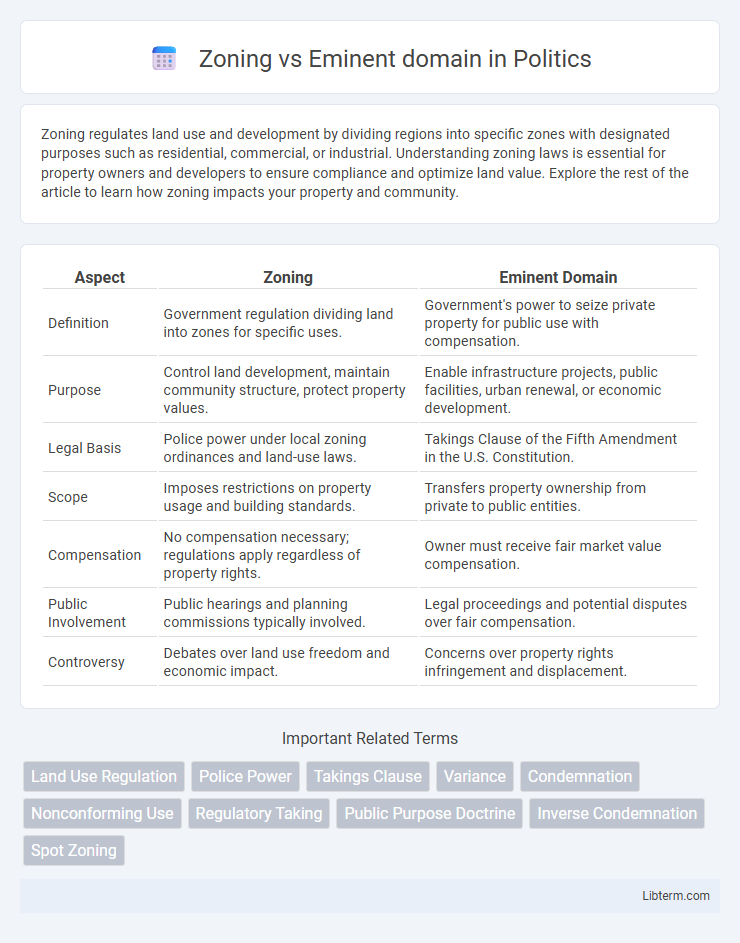Zoning regulates land use and development by dividing regions into specific zones with designated purposes such as residential, commercial, or industrial. Understanding zoning laws is essential for property owners and developers to ensure compliance and optimize land value. Explore the rest of the article to learn how zoning impacts your property and community.
Table of Comparison
| Aspect | Zoning | Eminent Domain |
|---|---|---|
| Definition | Government regulation dividing land into zones for specific uses. | Government's power to seize private property for public use with compensation. |
| Purpose | Control land development, maintain community structure, protect property values. | Enable infrastructure projects, public facilities, urban renewal, or economic development. |
| Legal Basis | Police power under local zoning ordinances and land-use laws. | Takings Clause of the Fifth Amendment in the U.S. Constitution. |
| Scope | Imposes restrictions on property usage and building standards. | Transfers property ownership from private to public entities. |
| Compensation | No compensation necessary; regulations apply regardless of property rights. | Owner must receive fair market value compensation. |
| Public Involvement | Public hearings and planning commissions typically involved. | Legal proceedings and potential disputes over fair compensation. |
| Controversy | Debates over land use freedom and economic impact. | Concerns over property rights infringement and displacement. |
Understanding Zoning: Definition and Purpose
Zoning is a municipal tool used to regulate land use by dividing areas into specific zones such as residential, commercial, or industrial to maintain organized development and community standards. Its purpose is to control growth, promote public health and safety, and protect property values by restricting the types of activities or buildings allowed in each zone. Unlike eminent domain, which involves government acquisition of private property for public use, zoning focuses on land use regulation without transferring ownership.
What is Eminent Domain? Key Concepts Explained
Eminent domain is the government's power to seize private property for public use, provided fair compensation is given to the owner. This legal authority enables infrastructure projects like roads, schools, and utilities, balancing public benefit with individual property rights. Understanding eminent domain involves key concepts such as public use, just compensation, and due process protections.
Legal Foundations: Zoning Laws vs Eminent Domain Powers
Zoning laws derive authority from local government regulations designed to control land use and ensure community planning aligns with public welfare standards, typically under police power. Eminent domain powers are rooted in the Fifth Amendment of the U.S. Constitution, allowing the government to compulsorily acquire private property for public use, provided just compensation is given. While zoning restricts property use without compensation, eminent domain involves property transfer with fair market compensation mandated by law.
How Zoning Impacts Property Rights
Zoning regulations impose specific land-use restrictions that can limit how property owners develop or utilize their land, directly affecting property rights by controlling density, building height, and permissible activities. These ordinances aim to balance community interests with individual rights, potentially reducing property value by restricting commercial or residential uses. Unlike eminent domain, which involves government seizure of property, zoning modifies legal land-use parameters without transferring ownership, shaping property rights through regulatory means.
Eminent Domain: When the Government Takes Private Land
Eminent domain allows the government to take private land for public use, provided just compensation is given to the owner, as mandated by the Fifth Amendment of the U.S. Constitution. This power is often exercised for infrastructure projects, such as highways, schools, or utilities, where private ownership conflicts with community development needs. Unlike zoning, which regulates land use through local ordinances, eminent domain involves the actual transfer of land ownership to the government or authorized entities.
Comparison of Zoning and Eminent Domain Processes
Zoning involves regulatory control by local governments to designate land use categories such as residential, commercial, or industrial, shaping community development without transferring ownership. Eminent domain authorizes governments to forcibly acquire private property for public use, requiring fair compensation to property owners. While zoning modifies land use rights within existing ownership, eminent domain results in actual property acquisition through legal condemnation proceedings.
Benefits and Drawbacks of Zoning Regulations
Zoning regulations provide structured land-use planning that promotes orderly urban growth, reduces conflicts between incompatible uses, and enhances property values by maintaining neighborhood character. However, rigid zoning can limit property owners' flexibility, lead to exclusionary practices, and potentially stifle economic development by restricting certain types of businesses or housing. While zoning supports community goals and public welfare, it may also result in inefficiencies or social inequities if not carefully designed and enforced.
Eminent Domain Controversies and Challenges
Eminent domain controversies often arise from disputes over property owner rights, perceived government overreach, and inadequate compensation for seized land. Challenges include legal battles over fair market value assessments, conflicts with community interests, and potential abuses where property is transferred to private developers under the guise of public use. These issues generate ongoing debates about balancing public benefit with protecting individual property rights.
Property Owner Protections Under Zoning and Eminent Domain
Property owner protections under zoning laws include the right to use land according to designated regulations, with opportunities for appeals or variances when restrictions impact property use. Eminent domain allows governments to expropriate private property for public use, but property owners must receive just compensation based on fair market value. Legal safeguards require transparent procedures and impartial assessments to prevent abuse and ensure property owners' rights are upheld during eminent domain actions.
Zoning vs Eminent Domain: Key Differences and Implications
Zoning regulates land use through local government laws that designate specific areas for residential, commercial, or industrial purposes, ensuring organized urban development and community welfare. Eminent domain allows governments to compulsorily acquire private property for public use, provided just compensation is given, often facilitating infrastructure projects or urban renewal. The key differences lie in zoning's preventive regulatory role versus eminent domain's direct acquisition power, impacting property rights, development potential, and compensation expectations.
Zoning Infographic

 libterm.com
libterm.com